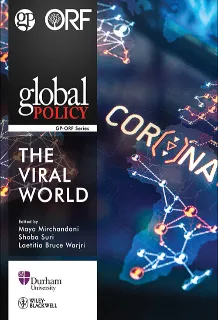Editors’ Note
This series of articles and essays paint a wide, anthropological canvas that delves into the impact of the novel coronavirus on geopolitics, world trade, public health and policy, and socio-economic interactions. In fact, it shines a light on human behaviour, and our lives and livelihoods in broad strokes. The pandemic has overshadowed every global crisis—whether terrorism or hot wars, energy security or climate change—and will have lasting impacts on the attainability of sustainable development. The impact is international and domestic, global and local, on communities as well as on the individual.
Historically, health epidemics have marked significant shifts in political, social and economic behaviour, and COVID-19 is no different. It has not only challenged humanity and its habits at an existential level but promises (or threatens) to change everything that was once familiar. World over, nations suffered deeply as a result of the Influenza epidemic in 1918, right after the end of First World War. As our writers point out, there are apparent similarities with the interventions that took place then and the ones that are taking place now to tackle COVID-19—identifying cluster outbreaks; containing hotspots; and focusing on sanitation, contact tracing and quarantining. A century later, under the cruel weight of another deadly contagion, the healthcare systems and economies of even the most developed nations have crumbled, exposing significant gaps that are exacerbated, in several cases, by disparities in the social contract where the older, the weaker and the marginalised have fallen victim either to the disease or to the hardship it has unleashed.
Italians, known for their consuming embraces in tight-knit family structures where generations divided by age interact closely every day, saw their elderly die in large numbers. Emerging from nearly two months of a complete lockdown, a grieving public is coming to terms with a new way of re-engagement—where human touch is absent and staying apart is considered the only way to stay together for the foreseeable future. Italy’s story of overwhelmed hospitals, doctors and nurses being forced to choose which patients had a better chance of survival—to decide how to optimise its ICU facilities—has been echoed across the Atlantic. In the US, New York City emerged as the global COVID-19 epicentre. Its doctors and nurses shattered any illusion that the world’s greatest superpower was ready to withstand the charge of the novel coronavirus. Protective gear was unavailable across the city’s inundated hospitals, the contagion was high, and it was clearly a mistake to assume—based on the casualties from Europe’s ageing populations—that it was only the old and the sick who were more at risk. Data from across New York hospitals also revealed that mortality figures indicated huge racial, ethnic and economic disparities. To ‘flatten the curve’—even though the city never went into the kind of lockdown that India saw—New York state governor Andrew Cuomo held daily briefings, issued guidelines for the public on what “shelter in place” meant, and displayed the kind of leadership in a crisis that was lacking in the White House.
Given what we have seen emerge from the world’s mightiest nations, it is easy to make the case, even if mistakenly, that the Global South has fared somewhat better. While India has made great strides since Independence in the eradication of epidemics like small-pox and polio, improved administrative responses to frequent viral illnesses, and made a name for itself in the manufacture of generic drugs, COVID-19 has felled much of this complacent confidence. Those making the case that a complete lockdown and the imposition of a punitive colonial-era Disease and Epidemic Act has helped India control its COVID-19 positive caseload can only do so hypothetically. The gradual lifting of a draconian lockdown, which was intended to buy time to ramp up testing and enhance medical preparedness, has revealed that little has been achieved on both fronts. Worse still, it has exposed and deepened fault-lines of class in Indian society, leading to further marginalisation, powerfully driven home by daily images of the exodus of migrant labourers from Indian cities. This has ended up causing unwarranted stigmatisation, particularly of minorities and the poor, who might have contracted the novel coronavirus.
In its fight against both—the pandemic and the economic hardship caused by sudden lockdowns in India—our writers argue that the Indian government is attempting to use existing financial inclusion programmes under Aadhaar and the Jan Dhan Yojana scheme to provide food and economic relief directly to those who need it the most. As images of despair, destitution, and hardship flood our TV screens with the march of ‘rurban’ labour, it is being argued that the development and use of mobile technology via the Arogya Setu app will allow people to be on the move by improving contact tracing and helping isolate positive cases. This is all, however, clearly dependent on ramping up testing capacity to much greater levels per capita than currently available.
Inspired by South Korea’s model, while the use of such apps might help States respond to a healthcare crisis, privacy rights advocates argue against their ‘big brother’ capabilities. In societies where technology can often be manipulated based on intent, it is important to ensure that in attempts to protect communities from a deadly pandemic, governments also ensure privacy and that the protection of individual freedoms. When autocrats and populist strongmen around the world use the fight against COVID-19 to suspend civil liberties, gag the media, or rule by decree, such concerns will only grow.
The fight against COVID-19 has been a wake-up call. If global conversations last year converged on real or perceived dangers to democratic systems fueled by populist leaders appealing to xenophobic, protectionist public emotions, the ability of COVID-19 to provide the ‘brahmastra’ to push their political agendas is, perhaps, unparalleled. World over, citizens fearful of the spread of a deadly virus have surrendered individual freedoms willingly and entrusted the State to provide healthcare, relief and economic stimulus as we follow safety advice. But major questions remain. Even as we mask up, maintain six feet of distance in public, life as we knew it has come to a grinding halt. With major cities across the world locking down businesses and workplaces, the magnitude of COVID-19’s impact on the world’s greatest economies is both shattering, and long-term. Disruptions in manufacturing and services have led to rising unemployment everywhere. In India, as migrant labourers walked home from cities to villages, individual stories of hardship merged into a collective humanitarian and economic crisis. Construction, manufacturing, retail, hospitality, tourism, aviation—not a single sector or industry has been spared. The smaller the business, the greater the hardship. But even big businesses are reeling. With global travel virtually non-existent, families divided by continents and time-zones do not know when they will meet each other next. As leaders appeal to their publics for economic self-reliance, interdependent industries are wondering whether the global citizens of the previous decade will return to their tribal, nativist identities out of fear. An international chorus seeking to hold China accountable for delays and lapses in communicating the magnitude of COVID-19’s impact could lead to major disruptions in manufacturing, as Chinese-led global supply chains stall. Will this mean a rise in domestic production around the world or a greater reliance on multilateralism between like-minded nations?
Most importantly, perhaps, we have to ask ourselves what lessons we the people are learning from the strangeness of our times. Our vocabularies have expanded—medical terminology has now become everyday speech. Administrators and public health practitioners hope this means that professions regarded as ‘ordinary’ will be valued and compensated in ways that they haven’t thus far; that we will have greater awareness and appreciation of what ‘essential services’ really mean. As epidemiologists, public health experts, doctors and economists analyse the spread of the virus across latitudes and longitudes, it is tempting to convince oneself of reasons for drastically different national responses and caseloads based on individual leadership. And if countries like South Korea, Germany, Norway and New Zealand are any indication, women leaders have been seen to prioritise healthcare as a national security challenge. While one of our authors admits that “typecasting gender is a fraught exercise,” nations with female leaders have evidently done much better at “flattening the curve” of COVID-19 than their strongman male counterparts in countries like the US, UK and Brazil.
As we await both a vaccine and a clinically tested treatment protocol, and as we hope to build herd immunity without losing more of our loved ones than we already have, perhaps the real learning for us will be to understand that when we emerge from this, we would have all lived through a pathogen that doesn’t recognise any distinction—of nationality, faith, gender or class. If the lack of face to face contact helps us appreciate its value more keenly, the over-arching lesson from this time of global crisis must be a public and administrative instinct towards greater empathy and understanding across societies and nations.
Contents
Editors’ Note
Pandemics Strike, Communities Respond
What Ghana Can Learn from Sierra Leone About Crisis Leadership
Corona-Immunity as Resource and Opportunity for Emerging Markets
Economic Vulnerabilities and Power Shifts in a Post-COVID-19 World
Doctors as Storytellers
Bend it Like Kerala: How an Indian State is Holding its Own Against COVID-19
Coexisting with COVID-19: Saving Lives and the Economy
A Viral Paradigm Shift
Measures to Address and Mitigate COVID-19 in OECD and BRICS Countries
Germany in the COVID-19 Crisis: More Robust than Other European Countries?
The Future of International Cooperation in Times of Existential Crises
Great Power Blame Game: The Ongoing War of Words Over COVID-19
Smaller South Asia: Competition for Influence Amid COVID-19 Response
COVID-19: Reading the Tea Leaves in China
How to Fight a Common Battle Against COVID-19 in a Leaderless World
Looking Back, Looking Forward
The World After COVID-19
Technology in the Times of a Global Pandemic: Lessons from India
The Pandemic in the Gulf: What it Portends for NRIs in the Region
Cohabiting with the Contagion: Lessons from History
Women Leaders are Doing Better in the COVID-19 Crises
The views expressed above belong to the author(s). ORF research and analyses now available on Telegram! Click here to access our curated content — blogs, longforms and interviews.

 PDF Download
PDF Download



 PREV
PREV




